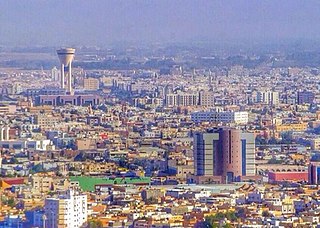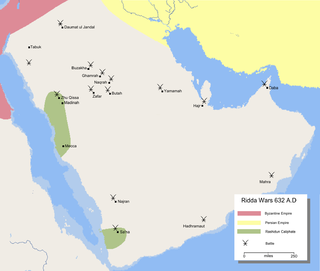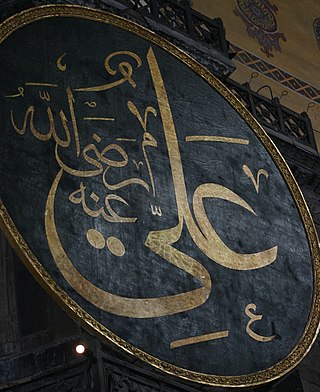
Abd Allah ibn Abi Quhafa, commonly known by his kunyaAbu Bakr, was the first caliph, ruling from 632 until his death in 634. As a senior companion of Muhammad and, through his daughter Aisha, also his father-in-law, Abu Bakr is referred to with the honorific title al-Siddiq by Sunni Muslims.

Muhammad was an Arab religious, social, and political leader and the founder of Islam. According to Islamic doctrine, he was a prophet divinely inspired to preach and confirm the monotheistic teachings of Adam, Abraham, Moses, Jesus, and other prophets. He is believed to be the Seal of the Prophets within Islam, with the Quran as well as his teachings and practices forming the basis for Islamic religious belief.

Year 632 (DCXXXII) was a leap year starting on Wednesday of the Julian calendar. The denomination 632 for this year has been used since the early medieval period, when the Anno Domini calendar era became the prevalent method in Europe for naming years.

The Hejaz is a region that includes the majority of the west coast of Saudi Arabia, covering the cities of Mecca, Medina, Jeddah, Tabuk, Yanbu, Taif and Baljurashi. It is thus known as the "Western Province", and it is bordered in the west by the Red Sea, in the north by Jordan, in the east by the Najd, and in the south by the Region of 'Asir. Its largest city is Jeddah, which is the second-largest city in Saudi Arabia, with Mecca and Medina, respectively, being the fourth- and fifth-largest cities in the country.

The Rashidun are the first four caliphs who led the Muslim community following the death of Muhammad: Abu Bakr, Umar, Uthman, and Ali.

Tabuk is the capital city of the Tabuk Region in northwestern Saudi Arabia. It has a population of 594,350. It is close to the Jordan–Saudi Arabia border and houses the largest air force base in Saudi Arabia.

The military career of Muhammad, the Islamic prophet, encompasses several expeditions and battles throughout the Hejaz region in the western Arabian Peninsula which took place in the final ten years of his life, from 622 to 632. His primary campaign was against his own tribe in Mecca, the Quraysh. Muhammad proclaimed prophethood around 610 and later migrated to Medina after being persecuted by the Quraysh in 622. After several battles against the Quraysh, Muhammad conquered Mecca in 629, ending his campaign against the tribe.

Rajab is the seventh month of the Islamic calendar. The lexical definition of the classical Arabic verb rajaba is "to respect", which could also mean "be awe or be in fear", of which Rajab is a derivative.
This is a timeline of major events in the Muslim world from 601 AD to 700 AD.
Umm Kulthūm bint 'Alī, also known as Zaynab al-Ṣughrā, was the youngest daughter of Fatima and Ali ibn Abi Talib. The former was the daughter of the Islamic prophet Muhammad and the latter was his cousin. Ali is also recognized as the fourth Rashidun caliph and the first Shia imam. A young Umm Kulthum lost her grandfather and mother in 632 CE. While she was still a child, the second Rashidun caliph Umar ibn al-Khattab asked for her hand in marriage, which was resisted by Umm Kulthum and her father Ali, possibly due to Umar's reputation for harsh treatment of women. By one Sunni account, Ali finally agreed to the marriage when Umar enlisted the support of prominent Muslims for his proposal.

The Ridda Wars were a series of military campaigns launched by the first caliph Abu Bakr against rebellious Arabian tribes. They began shortly after the death of the Islamic prophet Muhammad in 632 and concluded the next year, with all battles won by the Rashidun Caliphate.

The Battle of Mu'tah took place in September 629, between the forces of Muhammad and the army of the Byzantine Empire and their Ghassanid vassals. It took place in the village of Mu'tah in Palaestina Salutaris at the east of the Jordan River and modern-day Karak.

Abu Ayyub al-Ansari — born Khalid ibn Zayd ibn Kulayb ibn Tha'laba in Yathrib — was from the tribe of Banu Najjar, was a close companion and the standard-bearer of the Islamic prophet Muhammad. Abu Ayyub was one of the Ansar of the early Islamic history, those who supported Muhammad after the hijra (migration) to Medina in 622. The patronym Abu Ayyub, means father (abu) of Ayyub. Abu Ayyub died of illness during the First Arab Siege of Constantinople.

The first Islamic State or the State of Medina was the political entity established by Muhammad in Medina in 622 CE under the Constitution of Medina. It represented the political unity of the Muslim Ummah (nation). It was subsequently transformed into the caliphate by Muhammad's disciples, who were known as the Rightly Guided (Rashidun) Caliphs. The Islamic State significantly expanded under the Umayyad Caliphate (661–750) and consequently the Abbasid Caliphate (750–1258).
Muhammad, the final Islamic prophet, was born and lived in Mecca for the first 53 years of his life until the Hijra. This period of his life is characterized by his proclamation of prophethood. Muhammad's father, Abdullah ibn Abd al-Muttalib, died before he was born. His mother would raise him until he was six years old, before her death around 577 CE at Abwa'. Subsequently raised by his grandfather, Abd al-Muttalib, and then his uncle, Abu Talib ibn ‘Abd al-Muttalib, Muhammad's early career involved being a shepherd and merchant. Muhammad married Khadija bint Khuwaylid after a successful trading endeavour in Syria. After the death of Khadija and Abu Talib in the Year of Sorrow, Muhammad married Sawda bint Zam'a and Aisha.
Muhammad led the Conquest of Mecca in Ramadan of the Islamic year 8 AH. The Quraysh in Mecca was Muhammad's final major rival in the Arabian Peninsula, and following the conquest, Muhammad focused his military operations on further expansion of his Islamic realm to the north, with a campaign against the Ghassanids and the Byzantine Empire.

Ali ibn Abi Talib took part in all the battles of the Islamic prophet Muhammad's time, except the Expedition of Tabuk, as standard bearer. He also led parties of warriors on raids into enemy lands, and was an ambassador. Ali's fame grew with every battle that he was in, due to his courage, valour, and chivalry, as well as the fact that he single-handedly, destroyed many of Arabia's most famous and feared warriors. Muhammad acknowledged him as the greatest warrior of all time.
It is believed that Jews began immigrating to the Arabian Peninsula in as early as the 6th century BCE, when the Babylonian conquest of Judah triggered a mass Jewish exodus from Judea in the Land of Israel. Over time and through successive exiles, the local Jewish tribes, who were concentrated in the Hejaz and partly in South Arabia, established themselves as one of the most prominent ethno-religious communities of pre-Islamic Arabia. Likewise, Judaism, which had been introduced as one of the few monotheistic religions in the region, stood as a deviation from the typical polytheistic practices of Arabian paganism. These Jewish tribes continued to have a presence in Arabia during the rise of Muhammad, who founded Islam in the 7th century CE. Muhammad's interaction with the Jewish community is documented to a considerable degree in Islamic literature, including in many ahadith. The Jewish tribes of the Hejaz are seen in Islam as having been the offspring of the Israelites/Hebrews Two of Muhammad's wives were Jewish: Safiyya bint Huyayy and Rayhanah bint Zayd, both of whom belonged to the Banu Nadir by birth, though Rayhanah's status as a wife instead of a concubine is disputed.
Balī is an Arab tribe present in northwestern Saudi Arabia, Jordan and historically in Egypt and Sudan and a major component of the Quda'a tribal grouping. In the pre-Islamic period, the southern branches of the tribe inhabited northwestern Arabia and developed close ties with Jewish communities resident in its oases, while the northern branch established itself in Transjordan and served as auxiliaries of the Byzantine Empire. With the advent of Islam, Bali townspeople in Medina embraced the new religion and several were slain fighting the Quraysh of Mecca.












